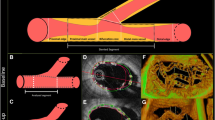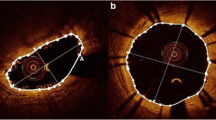Abstract
Heterogeneous neointimal response has been observed after implantation of all generations of coronary stents. Our aim was assessing local factors of shear stress (SS) and plaque characteristics in neointimal response after implantation of bioresorbable scaffolds (BRS) in bifurcations. Ten patients from the BIFSORB pilot study were analysed. Follow-up optical frequency domain imaging (OFDI) was performed at 1 month and 2 years. Coronary lumen and BRS structure were reconstructed by fusion of OFDI and angiography and were used for subsequent flow simulation. Plaque arc degree and SS were quantified using post-procedural OFDI data and were matched with follow-up OFDI using anatomical landmarks. Strut-level and segment-level analysis were performed for 1-month and 2-year follow-up respectively. A total of 444 struts (54 jailing struts) were included at 1-month follow-up. Time-average SS (TASS) was significantly lower for covered struts than for uncovered struts in non-bifurcation segments (TASS: 1.81 ± 1.87 vs. 3.88 ± 3.72 Pa, p < 0.001). The trend remained the same for jailing struts, although statistically insignificant (TASS: 10.85 ± 13.12 vs. 13.64 ± 14.48 Pa, p = 0.328). For 2-year follow-up, a total of 66 sub-regions were analysed. Neointimal hyperplasia area (NTA) was negatively correlated with TASS in core-segments (ρ = − 0.389, p = 0.037) and positively correlated with plaque arc degree in non-core segments (ρ = 0.387, p = 0.018). Slightly stronger correlations with NTA were observed when combining TASS and plaque arc degree in both core segments (ρ = − 0.412, p = 0.026) and non-core segments (ρ = − 0.395, p = 0.015). Hemodynamic microenvironment and baseline plaque characteristics may regulate neointimal response after BRS implantation in bifurcation. These findings underline the combined role of plaque characteristics and local hemodynamics in vessel healing after stent implantation.



Similar content being viewed by others
Abbreviations
- BMS:
-
Bare metal stents
- BRS:
-
Bioresorbable scaffolds
- CFD:
-
Computational fluid dynamics
- DES:
-
Drug-eluting stents
- ISR:
-
In-stent restenosis
- IST:
-
In-stent thrombosis
- IVUS:
-
Intravascular ultrasound
- OFDI:
-
Optical frequency domain imaging
- OCT:
-
Optical coherence tomography
- PCI:
-
Percutaneous coronary intervention
- SB:
-
Side branch
- SS:
-
Shear stress
- SSG:
-
Shear stress gradient
- TASS:
-
Time-average shear stress
- TASSG:
-
Time-average shear stress gradient
- NTA:
-
Neointimal hyperplasia area
- NHT:
-
Neointimal hyperplasia thickness
References
Inoue T, Croce K, Morooka T, Sakuma M, Node K, Simon DI (2011) Vascular inflammation and repair: implications for re-endothelialization, restenosis, and stent thrombosis. J Am Coll Cardiol Interv 4:1057–1066
Brugaletta S, Radu MD, Garcia-Garcia HM et al (2012) Circumferential evaluation of the neointima by optical coherence tomography after ABSORB bioresorbable vascular scaffold implantation: can the scaffold cap the plaque? Atherosclerosis 221:106
Shishido K, Antoniadis AP, Takahashi S et al (2016) Effects of low endothelial shear stress after stent implantation on subsequent neointimal hyperplasia and clinical outcomes in humans. J Am Heart Assoc 5:e002949
Bourantas CV, Papafaklis MI, Kotsia A et al (2014) Effect of the endothelial shear stress patterns on neointimal proliferation following drug-eluting bioresorbable vascular scaffold implantation: an optical coherence tomography study. J Am Coll Cardiol Interv 7:315–324
Shimada Y, Kataoka T, Courtney BK et al (2006) Influence of plaque calcium on neointimal hyperplasia following bare metal and drug-eluting stent implantation. Catheter Cardiovasc Interv 67:866–869
Farb A, Weber DK, Kolodgie FD, Burke AP, Virmani R (2002) Morphological predictors of restenosis after coronary stenting in humans. Circulation 105:2974–2980
Holck EN, Fox-Maule C, Barkholt TØ et al (2019) Procedural findings and early healing response after implantation of a self-apposing bioresorbable scaffold in coronary bifurcation lesions. Int J Cardiovasc Imaging. https://doi.org/10.1007/s10554-019-01537-5
Li Y, Gutiérrez-Chico JL, Holm NR et al (2015) Impact of side branch modeling on computation of endothelial shear stress in coronary artery disease: coronary tree reconstruction by fusion of 3D angiography and OCT. J Am Coll Cardiol 66:125–135
Tu S, Barbato E, Köszegi Z et al (2014) Fractional flow reserve calculation from 3-dimensional quantitative coronary angiography and TIMI frame count: a fast computer model to quantify the functional significance of moderately obstructed coronary arteries. J Am Coll Cardiol Interv 7:768–777
van Ditzhuijzen NS, Karanasos A, Bruining N et al (2014) The impact of Fourier-Domain optical coherence tomography catheter induced motion artefacts on quantitative measurements of a PLLA-based bioresorbable scaffold. Int J Cardiovasc Imaging 30:1013–1026
Nakatani S, Sotomi Y, Ishibashi Y et al (2016) Comparative analysis method of permanent metallic stents (XIENCE) and bioresorbable poly-L-lactic (PLLA) scaffolds (Absorb) on optical coherence tomography at baseline and follow-up. EuroIntervention 12:1498–1509
Tearney GJ, Regar E, Akasaka T et al (2012) Consensus standards for acquisition, measurement, and reporting of intravascular optical coherence tomography studies: a report from the International Working Group for Intravascular Optical Coherence Tomography Standardization and Validation. J Am Coll Cardiol Interv 59:1058–1072
Wentzel JJ, Krams R, Schuurbiers JC et al (2001) Relationship between neointimal thickness and shear stress after Wallstent implantation in human coronary arteries. Circulation 103:1740–1745
Gijsen FJ, Oortman RM, Wentzel JJ et al (2003) Usefulness of shear stress pattern in predicting neointima distribution in sirolimus-eluting stents in coronary arteries. Am J Cardiol 92:1325–1328
Papafaklis MI, Bourantas CV, Theodorakis PE et al (2010) The effect of shear stress on neointimal response following sirolimus-and paclitaxel-eluting stent implantation compared with bare-metal stents in humans. J Am Coll Cardiol Interv 3:1181–1189
Suzuki N, Nanda H, Angiolillo DJ et al (2008) Assessment of potential relationship between wall shear stress and arterial wall response after bare metal stent and sirolimus-eluting stent implantation in patients with diabetes mellitus. Int J Cardiovasc Imaging 24:357–364
Li Y, Li Z, Holck EN et al (2018) Local flow patterns after implantation of bioresorbable vascular Scaffold in coronary bifurcations—novel findings by computational fluid dynamics. Circ J 82:1575–1583
Thondapu V, Tenekecioglu E, Poon EK et al (2018) Endothelial shear stress 5 years after implantation of a coronary bioresorbable scaffold. Eur Heart J 39:1602–1609
Bourantas CV, Papafaklis MI, Lakkas L et al (2014) Fusion of optical coherence tomographic and angiographic data for more accurate evaluation of the endothelial shear stress patterns and neointimal distribution after bioresorbable scaffold implantation: comparison with intravascular ultrasound-derived reconstructions. Int J Cardiovasc Imaging 30:485–494
Foin N, Gutiérrez-Chico JL, Nakatani S et al (2014) Incomplete stent apposition causes high shear flow disturbances and delay in neointimal coverage as a function of strut to wall detachment distance: implications for the management of incomplete stent apposition. Circ Cardiovasc Interv 7:180–189
Koskinas KC, Chatzizisis YS, Antoniadis AP, Giannoglou GD (2012) Role of endothelial shear stress in stent restenosis and thrombosis: pathophysiologic mechanisms and implications for clinical translation. J Am Coll Cardiol 59:1337–1349
Corban MT, Eshtehardi P, Suo J et al (2014) Combination of plaque burden, wall shear stress, and plaque phenotype has incremental value for prediction of coronary atherosclerotic plaque progression and vulnerability. Atherosclerosis 232:271–276
Halwani DO, Anderson PG, Brott BC, Anayiotos AS, Lemons JE (2012) The role of vascular calcification in inducing fatigue and fracture of coronary stents. J Biomed Mater Res B 100:292–304
Morlacchi S, Pennati G, Petrini L, Dubini G, Migliavacca F (2014) Influence of plaque calcifications on coronary stent fracture: a numerical fatigue life analysis including cardiac wall movement. J Biomech 47:899–907
Funding
The study was supported by the Natural Science Foundation of China (Grant No. 81871460) and Program of Shanghai Technology Research Leader.
Author information
Authors and Affiliations
Corresponding author
Ethics declarations
Conflict of interest
Yingguang Li is employed by Medis medical imaging systems bv and has a research appointment at the Leiden University Medical Center (LUMC). Shengxian Tu received a research grant from Medis medical imaging and Pulse medical imaging technology, and Niels R. Holm received research grants from Medis medical imaging, Abbot, and Boston Scientific. All other authors declare that they have no conflict of interest.
Additional information
Publisher's Note
Springer Nature remains neutral with regard to jurisdictional claims in published maps and institutional affiliations.
Rights and permissions
About this article
Cite this article
Chu, M., Gutiérrez-Chico, J.L., Li, Y. et al. Effects of local hemodynamics and plaque characteristics on neointimal response following bioresorbable scaffolds implantation in coronary bifurcations. Int J Cardiovasc Imaging 36, 241–249 (2020). https://doi.org/10.1007/s10554-019-01721-7
Received:
Accepted:
Published:
Issue Date:
DOI: https://doi.org/10.1007/s10554-019-01721-7




